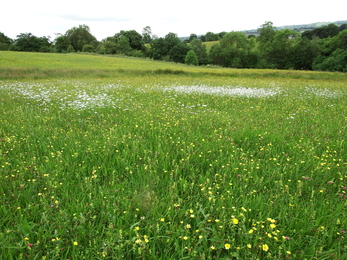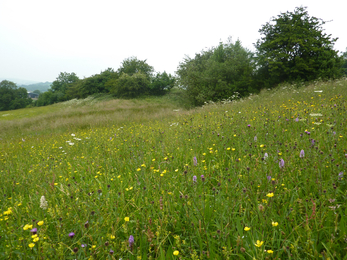The expansion of our beautiful wildflower meadows is a wonderful legacy for communities everywhere to enjoy. The magnificent sight of wild orchids shimmering in a field of delicate wild grasses in the afternoon sun to the hum of bees is something that everyone deserves to experience and enjoy.Staffordshire Wildlife Trust
|
In the face of the catastrophic loss of 97 per cent of our wildflower meadows since the 1930s, the plan was to create new and restored meadows using donor seed from remaining fragments of ancient and traditional meadows. The Wildlife Trusts and Plantlife – charities for whom the former Prince of Wales was patron – worked together to identify 60 species-rich meadows which are known as Coronation Meadows, one for every year of the Queen’s reign at that time. In Staffordshire Rod Wood near Cheddleton was selected. These special places became donors to provide precious seed to increase the amount of valuable and beautiful wildflower habitat elsewhere. The charities have since carried out an audit of the success of the project which reveals that a fantastic 101 new wildflower meadows have been created or restored since the Coronation Meadows project began a decade ago. In Staffordshire almost two hectares of meadows were enhanced at Cecily Brook, Cheadle. Rod Wood has also helped create over 15 hectares of wildflower meadows in other parts of the county. The charities are delighted that the Coronation Meadows project has increased the number of wildflower meadows and benefitted a vast array of wildlife, from bees and butterflies to bats and birds. The area is still expanding as the charities continue to harvest and spread the wildflower seed in localities close to the original sites, so that the distinctive character of each area’s flora is preserved. Biffa Award, through the Landfill Communities Fund, contributed £1million to fund the equipment and training needed for meadow restorations. In the first three years of the project alone, more than 700 volunteers gave their time to get the project off the ground. Seed was harvested from Coronation Meadows donor sites either as green hay, brush harvested seed or by hand, and this was used to seed second sites in the same area. Jeff Sim, Head of Nature Reserves and Species Recovery at Staffordshire Wildlife Trust, said: “The expansion of our beautiful wildflower meadows is a wonderful legacy for communities everywhere to enjoy. The magnificent sight of wild orchids shimmering in a field of delicate wild grasses in the afternoon sun to the hum of bees is something that everyone deserves to experience and enjoy. “As the nature and climate crises deepen, we must be bold if we want to reverse declines and help revive our meadow heritage. Ancient meadows have evolved alongside traditional farming methods over hundreds of years. “Many of meadows have been selected as Local Wildlife Sites because of the rare and threatened plants found there, but they have limited protection in planning policy. The next review of the National Planning Policy Framework later this year must see their protection strengthened. We also need to see greater support for wildflower meadows in the new farm environment schemes – it is critical that farmers are rewarded for restoring locally distinctive natural habitats where wild plants can thrive.” |
Ian Dunn, CEO, Plantlife, said:
“If you can, this Coronation year, make the opportunity to sit within an area of meadow or uncut grass. Look around at the colours and variety of plants. Then close your eyes and sense your surroundings through sound and smell. You’ll be amazed, reconnected with nature and feel just fantastic!
“We know healthy habitats such as meadows form the foundations of all successful conservation, as well as being at the roots of a healthy society and in addressing the climate challenges we face. At Plantlife we aspire to create a combined area equal to 20,000 new football fields of meadows before the end of this decade to give everyone the chance of experiencing the beauty and wildlife-rich meadows that were once commonplace. The exquisite Coronation meadows started 10 years ago give us confidence we can do so”.
Staffordshire’s Coronation Meadows
Cecilly Brook, Cheadle
This nature oasis within the town of Cheadle already featured some ancient flower-rich meadows. In 2015 these were complemented by the enhancement of further areas, creating a stunning flower-rich place for summer visitors. The site is now cared for by Staffordshire Wildlife Trust and is owned by Staffordshire Moorlands District Council. Selected areas of the site received green hay taken from Rod Wood the donor Coronation Meadow. The hay was cut and spread over areas of Cecily Brook creating almost two hectares of enhanced species-rich meadows. These areas provide food and the grasses give shelter for numerous insects and mammals each summer.
Find more information and Cecily Brook’s location to plan a visit here.
Rod Wood, Cheddleton
In 2013, the reserve was recognised as a Staffordshire Coronation Meadow. Green hay cut and collected from the site was used to enhance wild flower meadows at Cecily Brook.
This site has rare ancient pasture and hay meadows, rich with yellow rattle, orchids, oxeye daisies, eyebright and knapweed, all providing vital food sources for pollinating insects. On warm sunny days visitors expect to spot butterflies including meadow brown, speckled wood and green hairstreak.
Find more information and Rod Wood’s location to plan a visit here.
|
For more information on the Coronation Meadows project head here http://coronationmeadows.org.uk The original Coronation Meadows project brought together Plantlife, The Wildlife Trusts and the Rare Breeds Survival Trust, to celebrate surviving meadows, create new ones and encourage people to discover and enjoy their local special places for wildflowers. |


